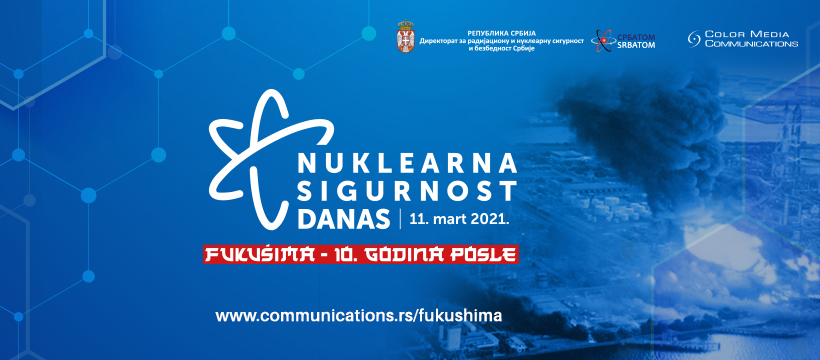Serbian Radiation and Nuclear Safety and Security Directorate (SRBATOM) has organized the online conference on 10 years since the Fukushima nuclear accident under the name of Sustain Nuclear Safety – 10 years After.
Vedrana Vuletic, Head of Unit for monitoring, control and emergency situations in SRBATOM, had a lecture on the consequences and reactions in Serbia following the accident at Fukushima Daiichi Nuclear Power Plant.
The accident at Fukushima Daiichi Nuclear Power Plant was the result of a devastating earthquake and tsunami that struck the eastern coast of Japan on 11 March 2011. As a result of the earthquake and tsunami, more than 18,500 people died, but none has been registered as victims of excessive exposure within the power plant. The power plant is 220 km away from Tokyo so that tens of thousands of people were evacuated from Fukushima Prefecture.
These two natural disasters incapacitated the reactor cooling systems, which led to a nuclear accident and discharge of radioactive material into the environment, primarily air, and then water as well. Consequently, the transboundary impact was felt in the countries not only in the vicinity of Japan, but those much further away, such as Serbia.
FUKUSHIMA AFTERMATH IN SERBIA
The distance between Serbia and Belgrade and the accident location is more than 9,000 km, which is important in order to understand the route these radioactive substances had to travel to reach our country, and the impact they might have had after being diluted during their transport through the air. Although the radioactive substances from Fukushima were airborne to Serbia and detected by the instruments in our national laboratories, their concentrations were quite low and required no protective measures planned in case of such a nuclear accident. Iodine-131, Caesium-137, and Caesium-134 were detected. These are three radioactive isotopes generated in nuclear reactors that can be discharged in the environment during an accident.
In comparison with the radioactivity values measured in Serbia after the Chernobyl accident, these values were between 1,000 and 10,000 times lower.
WHAT DID SERBIAN REGULATORY BODY DO?
Back then, Serbian Radiation Protection and Nuclear Safety Agency made the first step – to inform the public and to require the laboratories responsible for environmental radioactivity measurement to increase the frequency of their measurements in the air and precipitation, as these are considered to be the primary sources of radioactive fallout. However, this did not mean that the other aspects of the environmental monitoring were neglected; thus, our laboratories were required to analyze milk, grass, and other samples as well.
The public was regularly informed on the circumstances in Serbia, that is, the impact of the accident on our country. There were also dedicated phone lines for the citizens, and there was an intensive cooperation with the International Atomic Energy Agency as the source of reliable and official information on nuclear accidents worldwide.
Serbian Radiation Protection and Nuclear Safety Agency (now the Directorate) regularly released announcements on its website, and the Agency’s experts regularly gave statements for the press or news sections on TV and radio.
The Fukushima accident did not have a significant impact on the public in Serbia, especially in terms of the background radiation dose, where the impact was negligible. However, the Fukushima accident had a significant impact on further development of the system of protection and rescue during a nuclear or a radiological emergency, not only in Serbia, but other parts of the world as well.
Plan of Protection and Rescue
The Plan of Protection and Rescue covering nuclear or radiological accidents, whose preparation took several years, was finally adopted in 2018. It was developed in line with the national regulations and the relevant documents of the European Commission and the International Atomic Energy Agency. The Plan needs to be reviewed every three years.
The representatives of the Directorate are also a part of the work group for the preparation of the state plan of protection and rescue covering all identified risks in the Republic of Serbia.
JRodos Program
JRodos program, providing support in decision-making process during emergencies, was installed in Serbia as a part of the European Commission project, and is currently being adjusted and filled with data specific for Serbia. Once the appropriate parameters have been entered, the program will generate calculations and assessments of the contamination in the air, soil, foodstuffs, and feeding stuff.
This is a very complex action program with a wide use during planning, before an accident, and during an accident, as it can assist in the decision-making process and the implementation of the protective measures. Beside this, the program has its use in the period following the accident, during the stages of rehabilitation as it can help in deciding whether there is a need for remediation measures in a certain territory or area.
ConvEx-3 Exercise
Serbian Radiation and Nuclear Safety and Security Directorate took part in ConvEx-3 exercise, which was organized by the IAEA and Hungary in 2017. The exercise served to simulate the response to an accident in the NPP Paks in Hungary. This exercise was successfully organized in Serbia with the Sector for Emergency Situations, Ministry of Foreign Affairs, Ministry of Agriculture and Environmental Protection, Ministry of Education, Science and Technological Development, Ministry of Health, Ministry of Defense, the Republic Hydrometeorological Service of Serbia, other competent institutions, and the Directorate, of course. The aim of the exercise was to strengthen the cooperation between the state and the international organizations during emergencies, to ensure swift information exchange, and to test the mechanisms of public information. The exercise took 36 hours with the participants in other bodies receiving and processing the information, and then applying protective measures in the same manner as in the event of a real accident.
The exercise showed that, even in case of this type of an accident, Serbia has the appropriate schemes to respond, and prepared mechanisms for the protection and rescue. Needless to say, this does not imply we intend to stop acting in the field of protection and rescue, as this is the area with the ever-increasing potential for improvement.
You can read the news on our website, and you can see the entire conference on SRBATOM’s YouTube channel.

